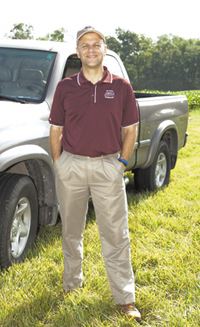|
Thwart Plant Diseases
Pathologist Offers Ways To Protect Plants In Growing Season
BETTY VALLE GEGG-NAEGER
MidAmerica Farmer Grower
BELLEVILLE, ILL.
Farmers learned the methods for curbing plant diseases from a talk by Dr. Jason Bond, plant pathologist at Southern Illinois University, who spoke at the Belleville Research Station Field Day recently.

Dr. Jason Bond, plant pathologist at Southern Illinois University, discusses different disease pressures in plant production in Illinois.
Photo by John LaRose, Jr.
“Each year presents different disease pressures in plant production in Illinois,” he began. “Last year we had a drought so the diseases that we normally see weren’t there. But we still had some diseases like charcoal rot of soybean, things like soybean cyst nematode which occurred because the conditions really don’t matter for these diseases; as long as you have a plant that’s growing in a field, those pathogens will attack soybean and in many cases even corn in the case of charcoal rot.”
Charcoal rot is a fungal disease, whereas soybean cyst nematode will only attack soybean and related plant species. Bond also considered the problems facing farmers this year.
“Obviously this year is a lot different. Some farmers were blessed because they were able to get things planted in a very timely manner. Some farmers are still dealing with that. In each one of those cases there is a different environmental parameter that governs what diseases will develop. The pathogens that cause these diseases are in all fields; but the environment that is needed for the production of the crop or the pathogen to have a healthy population differs from year to year,” he explained.
In the case where someone may have planted early there’s the problem with seedling diseases like Pythium and Phytophthora. Some variety selection decisions need to be made with regards to combating Phytophthora, however seed treatments are one management tool.
“Those decisions, obviously, had to be done in November when planning for the next year’s crop,” Bond said. “We have some other diseases that we will be dealing with probably later in the year, like soybean sudden death syndrome. Farmers who planted their crops in May, with the amount of rainfall that we’ve had and the very cool conditions, probably will see pockets of very severe sudden death syndrome.
“That disease is also managed with proper variety selection, so my take home message in regards to most of the diseases that we deal with, those that are living in the soil that all fields have, you have to address them with seed selection, and in many cases seed treatments,” he cautioned. “Foliar diseases are the only group of pathogens where decisions can be made within the reproductive stages of the crop, where we decide whether or not we should spray a fungicide.”∆
BETTY VALLE GEGG-NAEGER: Senior Staff Writer, MidAmerica Farmer Grower
|
|